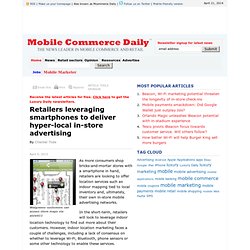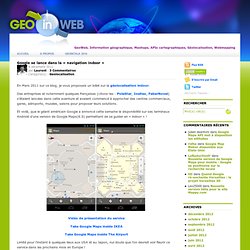

Retailers embrace in-store mapping via smartphones to facilitate shopping - Mobile Commerce Daily - Content. In a sign of the growing role that mobile plays in the in-store shopping experience, more than 12,000 retail locations, including those of Walgreens and The Home Depot are offering indoor searchable store maps accessible from a smartphone. Using aisle411’s in-store mapping platform, smartphone users can view, search and map products in retail stores. Users are able to locate products down to a particular section of each aisle. “Shoppers want the mobile in-store experience to be simple, and they want answers extremely fast,” said Nathan Pettyjohn, CEO of aisle411 , St.
Louis. “Therefore, we’ve found that having a native maps platform where maps can be cached on a mobile device, and searches can be done quickly through a simple Web service enhances the experience and keeps the shoppers engaged. “Simple product location search results are critical to keeping a shopper engaged,” he said. Aisle411’s results show that use of indoor searchable maps varies by retail category. Like this article? What is WiFiSLAM and Why Did Apple Want It? A couple of days ago the news broke that Apple had acquired indoor location startup WiFiSLAM.

Since the company immediately pulled its website and Apple isn’t exactly forthcoming about its plans for its acquisitions, much of the chatter since then has been speculation. But, thanks to a video of a detailed WiFiSLAM presentation (thanks Brian) at a Geo Meetup, we now have more information about the exact technologies that WiFiSLAM was using to pull off its indoor magic. We also know what SLAM means and why Apple was so interested in this particular company. Apple has been gathering location data based on trilateration (or triangulation) of WiFi and cellular signals for some time. You may recall the location database mini-debacle of 2011, when it was made clear that Apple, Google and other companies used WiFi hotspots and cell towers to track users and improve their networks.
A traditional WiFi + cellular tower location database The SLAM acronym? A path gathered with standard phone sensors. Une société coréenne réinvente le shopping en supermarché avec votre Smartphone ! Retailers leveraging smartphones to deliver hyper-local in-store advertising - Mobile Commerce Daily - Advertising. Walgreens customers can access store maps via aisle411 As more consumers shop bricks-and-mortar stores with a smartphone in hand, retailers are looking to offer location services such as indoor mapping tied to local inventory and, ultimately, their own in-store mobile advertising networks.

In the short-term, retailers will look to leverage indoor location technology to find out more about their customers. However, indoor location marketing faces a couple of challenges, including a lack of consensus on whether to leverage Wi-Fi, Bluetooth, phone sensors or some other technology to enable these services. “In the last six to twelve months there has been a shift in retailers being slightly aware of this to now where they are starting to make moves to actually implement this,” said Patrick Connolly, London-based senior analyst at ABI Research. “What we are starting to see now is companies doing indoor mapping and building basic services like shopping lists around it,” he said. The shopkick app. Google veut déployer la géolocalisation "indoor" - Blogs tEchosphère. Google se lance dans la « navigation indoor »
En Mars 2011 sur ce blog, je vous proposais un billet sur la géolocalisation indoor.

Des entreprises et notamment quelques françaises (citons-les : PoleStar, Insiteo, FaberNovel) s’étaient lancées dans cette aventure et avaient commencé à approcher des centres commerciaux, gares, aéroports, musées, salons pour proposer leurs solutions. Et voilà, que le géant américain Google a annoncé cette semaine la disponibilité sur ses terminaux Androïd d’une version de Google Maps(6.0) permettant de se guider en « indoor » ! Vidéo de présentation du service Take Google Maps inside IKEA Take Google Maps inside The Airport Limité pour l’instant à quelques lieux aux USA et au Japon, nul doute que l’on devrait voir fleurir ce service dans les prochains mois en Europe !
Mais comment fait Google ? D’une part, il collecte en mode « crowdsourcing » les données, plans des lieux à cartographier. Parmi les acteurs français, quelques nouvelles récentes :